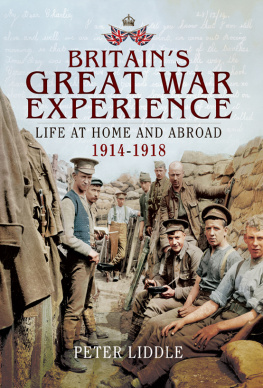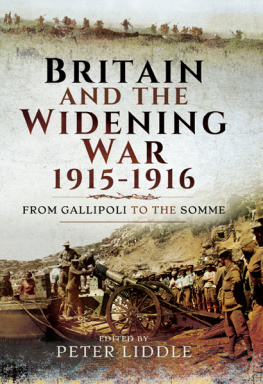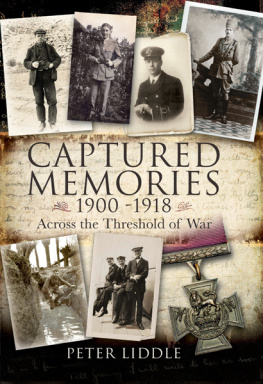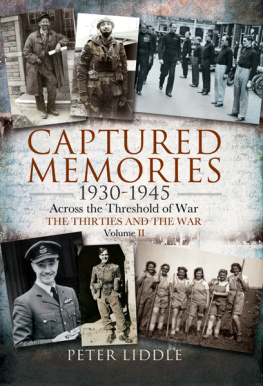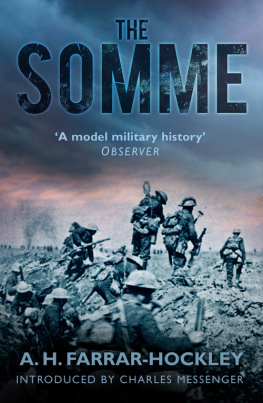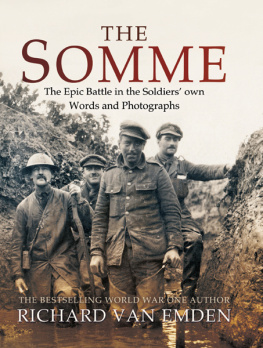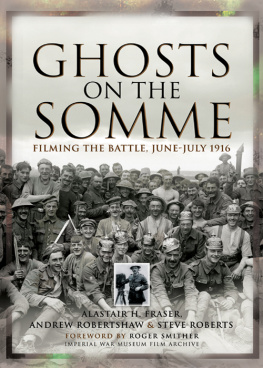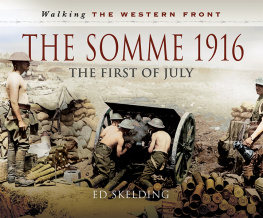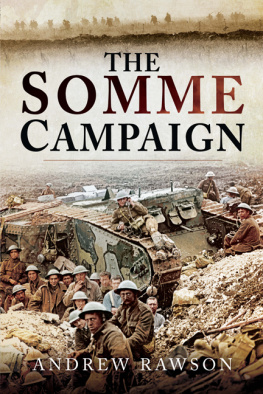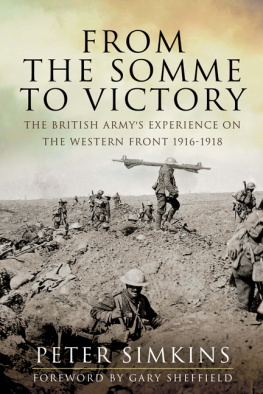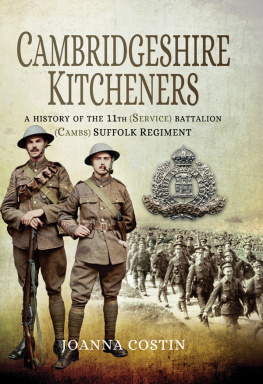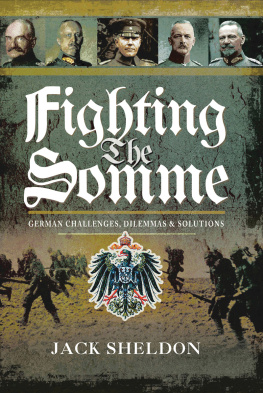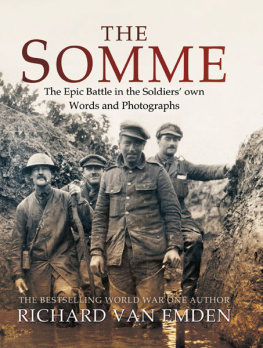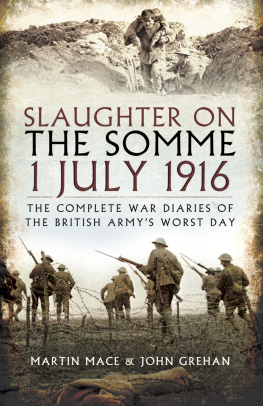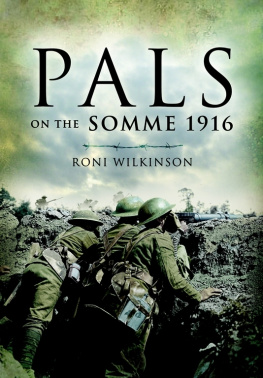First published in Great Britain in 2016 by
Pen & Sword Military
an imprint of
Pen & Sword Books Ltd
47 Church Street
Barnsley
South Yorkshire
S70 2AS
Copyright Peter Liddle 2016
ISBN: 978 1 78340 051 5
PDF ISBN: 978 1 47388 175 4
EPUB ISBN: 978 1 47388 174 7
PRC ISBN: 978 1 47388 173 0
The right of Peter Liddle to be identified as the Author of this Work has been asserted by him in accordance with the Copyright, Designs and Patents Act 1988.
A CIP catalogue record for this book is available from the British Library
All rights reserved. No part of this book may be reproduced or transmitted in any form or by any means, electronic or mechanical including photocopying, recording or by any information storage and retrieval system, without permission from the Publisher in writing.
Typeset in Ehrhardt by
Mac Style Ltd, Bridlington, East Yorkshire
Printed and bound in the UK by CPI Group (UK) Ltd,
Croydon, CRO 4YY
Pen & Sword Books Ltd incorporates the imprints of Pen & Sword Archaeology, Atlas, Aviation, Battleground, Discovery, Family History, History, Maritime, Military, Naval, Politics, Railways, Select, Transport, True Crime, and Fiction, Frontline Books, Leo Cooper, Praetorian Press, Seaforth Publishing and Wharncliffe.
For a complete list of Pen & Sword titles please contact
PEN & SWORD BOOKS LIMITED
47 Church Street, Barnsley, South Yorkshire, S70 2AS, England
E-mail:
Website: www.pen-and-sword.co.uk
Contents
List of Plates
Source of plates, Liddle Collection unless otherwise stated.
The chapter-head drawings are from the letters of Adrian Hill written during the Battle of the Somme. The letters are held in the Liddle Collection, Brotherton Library, the University of Leeds.
Maps
Acknowledgements
M y first acknowledgement must be to all the men and their families who over the years have entrusted their 1916 soldiering or air service memorabilia to my care. This is the material original letters, diaries, photographs, sketches, maps, official documents and recollections which has been both the books main source and its inspiration. I had long wanted to write it, and felt a responsibility so to do as I read and reflected upon so much original personal experience documentation, and reconsidered some of the generalisations made and uncritically accepted upon aspects of the First World War. My thanks to so many are offered with the anxious hope that the book would have rung true to the men who experienced the Somme and who, decades later, contributed to the archives I was building up. I am particularly touched that Reg Glenn, at John Copse, Serre, on 1 July 1916, should have honoured this book when first published by contributing a foreword.
The conditions for writing this book in its original form nearly twenty-five years ago were facilitated by my 191418 archive work becoming the Liddle Collection within the Library of the University of Leeds in 1988. To all those who worked to achieve this end I am indebted to an unfathomable degree. Some names are engraved indelibly on my conscience David Dilks, Alan Roberts and Reg Carr from the University, then Kenneth Rose, Paul Stobart and Brian Perry, among many more, known and unknown.
I remain sincerely appreciative of all those who helped in the production of the 1992 book The 1916 Battle of the Somme: a Re-Appraisal but specifically with regard to this new edition I must first acknowledge my debt to the recently-published research judgements of the historians Gary Sheffield, whose focus has been on the High Command, and William Philpott, whose attention has been directed towards the Battle of the Somme as a three-nation struggle, while my concentration had been on junior officers and men in the ranks.
From my publishers, Pen and Sword, through commissioning editor, Rupert Harding, I had the challenge of tackling this re-consideration, and I have welcomed the opportunity, confident that copy-editing, the illustrations and a new presentation of the book were in good hands. Once again, the hard-pressed staff and volunteers of regimental museums have been generous in their support and I thank in particular Ian Martin at the Museum of the Kings Own Scottish Borderers in Berwick and Sarah Stevenson and Philip Mather at the Fusiliers Museum in Bury, Lancashire.
At the Brotherton Library in the University of Leeds it was very special to be able to re-examine the letters of Philip Hirsh VC which I was privileged to accept from the donors but which came in after the publication of this book in 1992. This led me to look again through the material deposited by Philips brother, Frank, and whether or not it were to have been available for my use long ago, my goodness it fully deserved inclusion here.
The generosity of David Millichope in making available to me before the publication of his book on Halifax in the Great War, his text and research material on the Duke of Wellingtons West Riding Regiment, may be characteristic of a man leading such inspired research as is being undertaken by the Halifax Great War Society but it was still a wonderful gesture for which I remain particularly grateful.
Dealing with countless computer problems and issues of presentation, my beloved wife, Louise, has come to my rescue on occasion after occasion. In this respect my happily recognised debt goes far beyond academic matters.
In conclusion, this book is re-dedicated to those who were there, on the Somme, in 1916, and it is so dedicated, with profound respect.
Peter Liddle
Mickley, North Yorkshire, 2016
Foreword
H ow much I have enjoyed reading this comprehensive, illuminating history of the battles on the Somme in 1916. My perspective was that of the ordinary soldier, one of the Sheffield Pals in the 12th Battalion York and Lancaster Regiment. I knew little or nothing, of course, of the whole and greater organising of the battles but looking back today on my experience in 1916, I find the detail and spirit of this book truly convincing.
What memories it has stirred! The blowing of the mine, the sudden silence when the guns stopped and then the song of the skylark overhead.
I believe this book should be widely read, especially by new generations to whom the events must seem like distant history, for in reading this account it would be difficult for anyone to forget the men who made that distant history.
Reg Glenn of Oughtibridge, Sheffield, 1991, in 1916, Corporal Glenn, 12th (Service) Battalion (Sheffield), The York and Lancaster Regiment

The Battle of the Somme, 1 July to 20 November 1916.
Introduction: The Somme, Our Heritage

W ith a hundred years having passed since the 1916 Battle of the Somme, its mention still gives rise to deeply-felt emotion which swirls within all who have a sense of our recent history, that is the history which continues to resonate through experience within our own families, our villages, towns, cities and regions and because we recognise that the Great War had such a shaping effect on our world today.
History is no exact fixed science. Nor of course is memory memory as personally experienced or as received down the generations. Judgements, whether expressed by those remunerated for their study of the past, or held passionately from a range of influences by those outside the profession, or simply the opinions shaped by the education of received wisdom, will be subject to change. Furthermore, even in times of what appears conclusive approbation or condemnation, there will always be another point of view. There may be a swift readiness to dismiss such a point of view as not acceptable in these enlightened times, but it would, in all likelihood, have been more shrewd to be aware that with the passage of time, those discordant voices may herald the new wisdom. Whether one were to choose Henry VIII and the Dissolution of the Monasteries, the Civil War and the execution of King Charles I, the Peterloo Massacre, the iniquity or achievements of the British Empire, or indeed the 1916 Battle of the Somme, this has been the case and will continue to be the case. Todays verdict may be old hat if not tomorrow, then before too long. From the point of weighing matters up for oneself, the actual period of change in the balance of a debate, has much to commend it.
Next page

